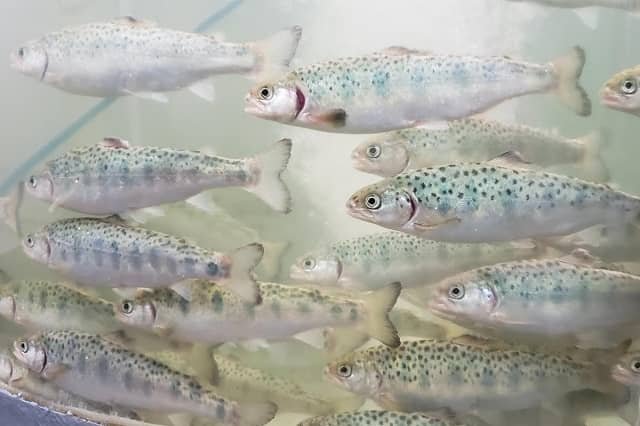
Imagine the fish gut as a bustling city packed with microscopic residents: billions of them! These tiny microbes, collectively known as gut microbiota, play a crucial role in the health and well-being of salmon. But what happens when unwanted guests arrive, such as intestinal parasites?
A new study by scientists from the Norwegian University of Science and Technology (NTNU), the University of Copenhagen, Aarhus University, the Institute of Marine Research, among other organizations, delves into the fascinating world of the hologenome, which considers the host (in this case, Atlantic salmon Salmo salar) and its microbiota as a single entity. By analyzing genes, intestinal content, and salmon growth performance, researchers shed light on how parasitic infections and individual genetic composition shape the gut ecosystem.
The Study
Traditionally, health studies focused on the host’s genes. But now we know that billions of microbes residing within fish (intestinal microbiota) play a crucial role. This study adopted a “hologenomic” approach, considering the combined influence of both the host and its microbial partners.
Led by researchers from Norway and the UK, the study focuses on Atlantic salmon, a crucial fish in the global food chain. Unfortunately, these fish often suffer from parasite infections, particularly tapeworms of the genus Eubothrium. These unwanted guests can hinder salmon growth and even cause death.
Scientists studied how the intestinal microbiome of 460 salmon, infected with varying levels of tapeworms, differed concerning their lifelong growth. They applied the hologenomic lens, considering fish and their intestinal microbes as a single “holobiont.” This means they analyzed not only the fish genes but also the genetic composition of their gut bacteria.
Key Findings
This holistic perspective reveals fascinating insights:
- Intrusive parasites: Salmon infected with cestode worms showed distinct intestinal microbiomes compared to their parasite-free counterparts. This suggests that worms alter the microbial balance, which could affect the host’s health and growth.
- Growth and gut: The study revealed a link between the composition of the intestinal microbiome and lifelong growth in salmon. Specific microbial communities appeared to be associated with faster or slower growth, highlighting the potential role of the microbiome in aquaculture optimization. The study linked smaller, parasite-infected salmon to an altered intestinal microbiome (“dysbiosis“). Instead of a dominant beneficial strain of “Mycoplasma,” these fish harbored a broader variety of microbes, some of which carried potential virulence genes. This suggests a potential link between dysbiosis and poor growth or parasite susceptibility.
- Genetics play a role: Interestingly, researchers found evidence that a salmon’s genes could influence how its intestinal microbiome responds to parasite infection. This personalized microbiome response opens intriguing avenues for understanding individual differences in health and disease susceptibility.
This hologenomic approach offers a new and powerful lens for understanding the complex interaction between hosts, their microbes, and parasites. By studying the holobiont as a whole, we can gain deeper insights into health, diseases, and even factors like growth in commercially important fish species.
Significance for the Salmon Industry
This study, the largest multiomic study on fish microbiota to date, provides valuable insights into the complex interaction between host, parasite, and intestinal microbes in Atlantic salmon. Understanding these interactions could lead to:
- Developing probiotics tailored to specific fish genotypes to enhance their resistance against parasites and promote growth: Identifying specific gut microbes associated with better growth could pave the way for specific probiotics or dietary interventions to optimize fish health and production.
- Combatting parasites: Understanding how parasites manipulate the intestinal microbiome could contribute to the development of novel strategies to control or mitigate their harmful effects.
- Personalized medicine: The link between individual genetics and microbiome response suggests the possibility of tailoring treatments or preventive strategies based on a fish’s unique microbial footprint.
This study demonstrates the power of hologenomics to understand complex biological phenomena. By analyzing both the host and its microbiome, researchers can gain deeper insights into how infections, genetics, and the environment interact to influence health and growth.
Stay Always Informed
Join our communities to instantly receive the most important news, reports, and analysis from the aquaculture industry.
Conclusion
The study is an important step toward understanding the intricate dance between fish, their gut microbes, and parasites. By adopting hologenomics, researchers can unlock new strategies to improve fish health, optimize aquaculture practices, and ultimately contribute to a more sustainable food system.
The hologenomic approach used in this study can be applied to various animals, including humans, and offers a deeper understanding of how our gut microbes interact with us and influence our health in the face of various challenges.
The study was funded by the FHF-Norwegian Seafood Research Fund, Danish National Research Foundation, the European Union’s Horizon 2020 program, and the Norwegian Research Council.
Contact
Jaelle C. Brealey
Department of Natural History, NTNU University Museum
Norwegian University of Science and Technology (NTNU)
Trondheim, Norway
Email: jaelle.brealey@nina.no
Reference (open access)
Brealey, J. C., Kodama, M., Rasmussen, J. A., Hansen, S. B., Santos-Bay, L., Lecaudey, L. A., … & Limborg, M. T. (2024). Host–gut microbiota interactions shape parasite infections in farmed Atlantic salmon. Msystems, e01043-23.
Editor at the digital magazine AquaHoy. He holds a degree in Aquaculture Biology from the National University of Santa (UNS) and a Master’s degree in Science and Innovation Management from the Polytechnic University of Valencia, with postgraduate diplomas in Business Innovation and Innovation Management. He possesses extensive experience in the aquaculture and fisheries sector, having led the Fisheries Innovation Unit of the National Program for Innovation in Fisheries and Aquaculture (PNIPA). He has served as a senior consultant in technology watch, an innovation project formulator and advisor, and a lecturer at UNS. He is a member of the Peruvian College of Biologists and was recognized by the World Aquaculture Society (WAS) in 2016 for his contribution to aquaculture.




